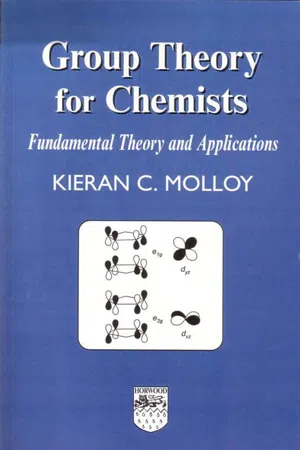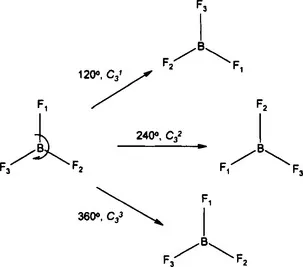
- 232 pages
- English
- ePUB (mobile friendly)
- Available on iOS & Android
About this book
The basics of group theory and its applications to themes such as the analysis of vibrational spectra and molecular orbital theory are essential knowledge for the undergraduate student of inorganic chemistry. The second edition of Group Theory for Chemists uses diagrams and problem-solving to help students test and improve their understanding, including a new section on the application of group theory to electronic spectroscopy.Part one covers the essentials of symmetry and group theory, including symmetry, point groups and representations. Part two deals with the application of group theory to vibrational spectroscopy, with chapters covering topics such as reducible representations and techniques of vibrational spectroscopy. In part three, group theory as applied to structure and bonding is considered, with chapters on the fundamentals of molecular orbital theory, octahedral complexes and ferrocene among other topics. Additionally in the second edition, part four focuses on the application of group theory to electronic spectroscopy, covering symmetry and selection rules, terms and configurations and d-d spectra.Drawing on the author's extensive experience teaching group theory to undergraduates, Group Theory for Chemists provides a focused and comprehensive study of group theory and its applications which is invaluable to the student of chemistry as well as those in related fields seeking an introduction to the topic.- Provides a focused and comprehensive study of group theory and its applications, an invaluable resource to students of chemistry as well as those in related fields seeking an introduction to the topic- Presents diagrams and problem-solving exercises to help students improve their understanding, including a new section on the application of group theory to electronic spectroscopy- Reviews the essentials of symmetry and group theory, including symmetry, point groups and representations and the application of group theory to vibrational spectroscopy
Frequently asked questions
- Essential is ideal for learners and professionals who enjoy exploring a wide range of subjects. Access the Essential Library with 800,000+ trusted titles and best-sellers across business, personal growth, and the humanities. Includes unlimited reading time and Standard Read Aloud voice.
- Complete: Perfect for advanced learners and researchers needing full, unrestricted access. Unlock 1.4M+ books across hundreds of subjects, including academic and specialized titles. The Complete Plan also includes advanced features like Premium Read Aloud and Research Assistant.
Please note we cannot support devices running on iOS 13 and Android 7 or earlier. Learn more about using the app.
Information
Symmetry

1.1 SYMMETRY

1.1.1 Rotations and Rotation Axes

Table of contents
- Cover image
- Title page
- Table of Contents
- About the Author
- Copyright
- Preface
- Part I: Symmetry and Groups
- Part II: Application of Group Theory to Vibrational Spectroscopy
- Part III: Application of Group Theory to Structure and Bonding
- Part IV: Application of Group Theory to Electronic Spectroscopy
- Appendices
- Index